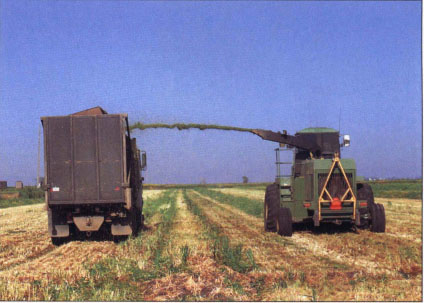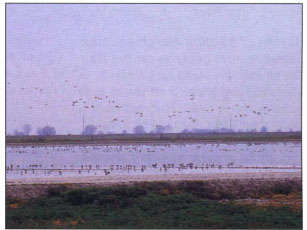All Issues
For the birds: Farmers accommodate wildlife
Publication Information
California Agriculture 53(3):10-11.
Published May 01, 1999
PDF | Citation | Permissions
Full text
Farmers often clash with environmentalists over issues such as land and water, but farmers who are also environmentalists are finding compatibility between farming and wildlife.
The California Waterfowl Association (CWA) is working with 18 agricultural landowners in the Sacramento Valley, who have built brood ponds for waterfowl. Eight have built permanent ponds, while 11 flood fields in the spring. CWA is comparing the year-round ponds to spring flooding to determine which is more beneficial.
Evidently if farmers build ponds, wildlife will come. Dawn Harris, a student monitoring the ponds for CWA, has observed 65 different bird species, including 11 waterfowl species, using the human-made ponds. “We have observed many species with special status at the federal or state level, including tricolored blackbird, Swainson's hawk, white-faced ibis, giant garter snake, and a bald eagle,” says Greg Yarris, CWA director of waterfowl programs.
CWA is also conducting rotational grazing projects with some cattle ranchers, who have put in fencing and rotate the herds through the fenced off areas, assuring undisturbed area for nesting habitat and high quality forage for cattle.
In this issue, UC scientists describe another way ranchers can help migratory waterfowl. In a study conducted at the Ash Creek Wildlife Area in Lassen and Modoc counties, they found that harvesting wild hay after nesting and brood-rearing enhances the abundance and diversity of birds that nest near wetlands ( see page 12 ).
Historically, the Central Valley had more than 4 million acres of wetlands, but over the years they were drained for agricultural and urban development. Today only about 350,000 acres of natural wetlands remain so efforts are being made to restore habitat.
Most farmers who cooperate with CWA are duck hunters, but there are a few who are embracing wildlife on a different level, says CWA president Bob McLandress. For example, McLandress was surprised to learn his Woodland neighbor Kevin Timothy was spending his lunch hours monitoring wood duck boxes.
“To me it's more therapeutic,” the processing tomato grower explains. Timothy enjoys shooing away predators that try to take over the nests, cleaning out the boxes and tallying the eggs. “I love seeing wildlife,” he says. “I spend 12 to 14 hours day in the field and I see them everyday. If I don't see them, I want to know what's wrong.”
Wood ducks stay in the box less than 24 hours after hatching so one must have good timing to see the babies. “Once you see those little wood ducks, they will take your heart,” Timothy says.
He also leaves growth along waterways and waits as long as he can to harvest his wheat so mallards will have places to nest.
Rice growers in the Sacramento area create habitat for waterfowl by flooding their fields in the winter. UC studies show that rice fields managed as wetlands can provide as much as 600 pounds of forage per acre, 80% of the amount of food found in natural wetlands.
Other approaches are being tried on dairy land. Joseph Gallo Farms is located along the 160,000 acres of contiguous wetlands of the Grassland Ecological Area and the San Luis National Wildlife Refuge Complex. Gallo Farms sold to the Fish & Wildlife Service development rights to 2,000 acres along the core of these wetlands and began restoring wetlands and integrating them with their pastures.
“Irrigated pastures are habitat for waterfowl, but we also graze our heifers there,” says Randy Riviere, director of environmental affairs for the 20,000-cow dairy. “The geese and cranes also like the cereal grains so it's dual purpose.”
Having worked as a production manager for Tri Valley Growers and private lands manager for the Fish and Wildlife Service, the wildlife biologist knows both sides of the business. While trying to achieve environmental goals, he is familiar with the operational constraints and human factors in farming.
Mike Gallo, who runs the operation, uses what Riviere calls “adaptive management.” When tricolored blackbirds began nesting in their silage fields, they delayed harvest and harvested the crop as grain instead.
Mixing farming with wildlife protection is “politically smart,” McLandress observes, “and will be an important consideration in making increasingly difficult decisions about land and water use in the next century.”






